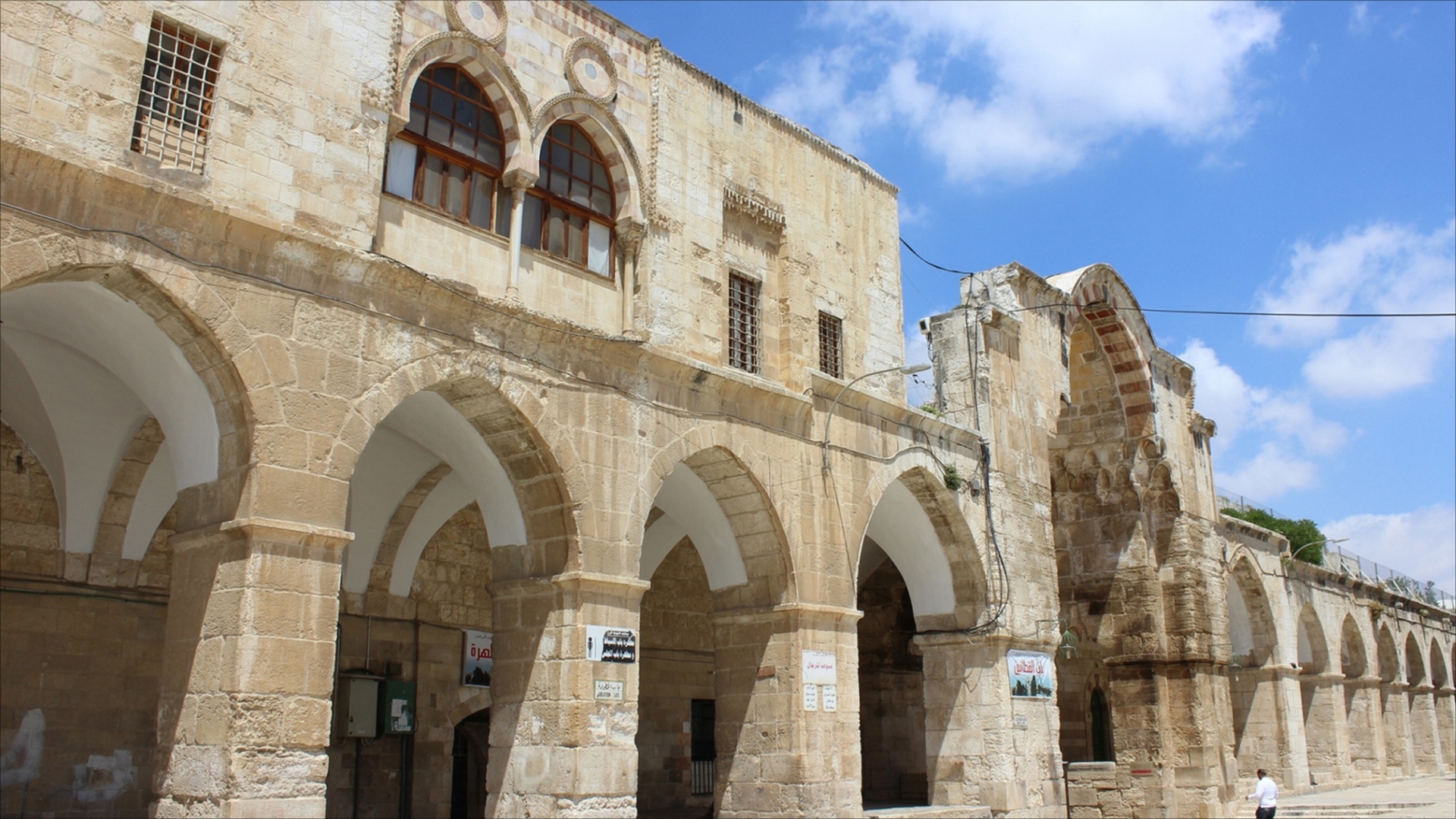Description
Property Name: The Ottoman School (in Al-Masjid Al-Aqsa)
Inventory No: 972-2-8
Date of infill of the inventory form: 2020-07-17
Country (State party): Palestine
Province: Al Quds/Jerusalem
Town: Old town
Geographic coordinates: 31°46’39.32″N
35°14’3.88″E
Historic Period: Ottoman
Year of Construction: 1436
Style: Early Islamic
Original Use: School
Current Use: House
Architect: Unknown
Significance
The Ottoman School is located at the Ablution Gate, next to Al- Ashrafiyah School. It is named after a Turkish lady, called Asfahan Shah Khatun Bint Mahmoud Al-’Uthmaniyah, who established it in 840 AH/1436 CE. The school consists of two floors and can be reached through a beautiful Mamluk entrance surmounted by the inscription of its foundation and decorated with alternating red and white stones. The school consists of a number of rooms and a small open courtyard, overlooking Al-Aqsa Mosque, with a façade made of red and white stones. There are two tombs to the left side of the entrance; one of them is for the lady who endowed it.
Selection Criteria
ii. to exhibit an important interchange of human values, over a span of time or within a cultural area of the world, on developments in architecture or technology, monumental arts, town-planning or landscape design
iii. to bear a unique or at least exceptional testimony to a cultural tradition or to a civilization which is living or which has disappeared
vi. to be directly or tangibly associated with events or living traditions, with ideas, or with beliefs, with artistic and literary works of outstanding universal significance
State of Preservation
The building was reconstructed by the Supreme Islamic Council, yet the school and its mosque sustained some damages because of the Israeli authorities’ excavations beneath it. The Israeli authorities have confiscated the school’s mosque allegedly to create ventilation for the tunnel beneath it.
References
ed. Auld, Sylvia and Hillenbrand, Robert; arch. survey by Yusuf Natsheh. Ottoman Jerusalem: the living city: 1517-1917. London: Altajir World of Islam Trust, 2000.
Al-Quds, A Historical Document. Organization of the Islamic Conference.
Bahat, Dan. A selection of Ottoman Structures in the old city of Jerusalem. Jerusalem: The Open University of Israel, 1990.
Bahat, Dan. Carta’s Historical Atlas of Jerusalem, 1983
Burgoyne, Michael Hamilton. Mamluk Jerusalem, an architectural study. Scorpion Publishing Ltd., Essex, England 1987
Creswell, K.A.C. A Short Account of Early Muslim Architecture. Penguin Books, Harmondswoth, 1958.
Duncan, Alistair, The Noble sanctuary: portrait of a holy place in Arab Jerusalem. London: Longman, 1972.
Elad, Amikam. Medieval Jerusalem and Islamic Holy Places, Ceremonies, Pilgrimage. |Brill Leiden, Netherlands, 1995.
Grabar, Oleg. Jerusalem, Constructing the Study of Islamic Art, Volume IV. Ashgate Publishing Company, Hampshire, 2005.
Grabar, Oleg. The Dome of the Rock. Thames and Hudson Ltd., London, 1996.
Ed. Hattstein, Markus, Delius. Peter. Islam Art and Architecture. Könemann Verlagsgesellshaft mbH, France, 2000.
Jerusalem Institute for Israel Studies, Statistical Yearbook of Jerusalem, 2002/03
Kroyanker, David. Jerusalem Architecture. Tauris Parke Books, London, 1994.
Najm, Raip Yusuf, The Treasures of Jerusalem. Arabic Cities Organization, Al-Beti Establishment, 1983.
Sha’th, Shawqi. Al-Quds Al-Shareef. ISESCO, Rabat,1995.
Wilson, Colonel Sir Charles W. Jerusalem, The Holy City. Ariel Publishing House, Jerusalem.
Flood, F.B. 1997. Umayyad Survivals and Mamluk Revivals: Qalawunid Architecture and the Great Mosque of Damascus. Muqarnas XIV: An Annual on the Visual Culture of the Islamic World. Gülru Necipoglu (ed). Leiden: E.J. Brill, 57-79.
Grabar, Oleg. The Haram al-Sharid: An Essay in Interpretation, BRIIFS vol.2 no.2 Autumn 2000.
Jarrar, Sabri. 1998. Suq al-Ma’rifa: An Ayyubid Hanbalite Shrine in al-Haram al-Sharif. Muqarnas XV: An Annual on the Visual Culture of the Islamic World. Gülru Necipoglu (ed.) Leiden: E.J. Brill, 71-100.
Khalidi, Walid. The Dome of the Rock. Retrieved from Saudi Aramco World website: http://www.saudiaramcoworld.com/issue/199605/the.dome.of.the.rock.htm
Khoury, Nuha N.N. 1993. The Dome of the Rock, the Ka’ba, and Ghumdan: Arab Myths and Umayyad Monuments. Muqarnas X: An Annual on Islamic Art and Architecture. Margaret B. Sevcenko (ed.). Leiden: E.J. Brill.
Laurent, B. and Riedlmayer, A. Restorations of Jerusalem and The Dome of The Rock and Their Political Significance, 1537-1928
Leisten, Thomas. 1996. Mashhad Al-Nasr: Monuments of War and Victory in Medieval Islamic Art. Muqarnas Volume XIII: An Annual on the Visual Culture of the Islamic World. Gülru Necipoglu (ed.). Leiden: E.J. Brill.
Rabbat, Nasser. 1989. The Meaning of the Umayyad Dome of the Rock. Muqarnas VI: An Annual on Islamic Art and Architecture. Oleg Grabar (ed.). Leiden: E.J. Brill.
Rabbat, Nasser. 1993. The Dome of the Rock Revisited: Some Remarks on al-Wasiti’s Accounts. Muqarnas X: An Annual on Islamic Art and Architecture. Margaret B. Sevcenko (ed.). Leiden: E.J. Brill.
Richard Ettinghausen, Oleg Grabar, Marilyn Jenkins-Madina (1987),The Art and Architecture of Islam 650-1250 c.e. (pp.28-34)
Yavuz, Yildirim. 1996. The Restoration Project of the Masjid al-Aqsa by Mimar Kemalettin (1922-26). Muqarnas Volume XIII: An Annual on the Visual Culture of the Islamic World. Gülru Necipoglu (ed.). Leiden: E.J. Brill.
UNESCO, (1995) General Conference Twenty-eighth Session Report
Archnet website: archnet.org


